| This article includes a list of general references, but it lacks sufficient corresponding inline citations. Please help to improve this article by introducing more precise citations. (October 2018) (Learn how and when to remove this message) |
| SirPeter Lely | |
|---|---|
 Self-portrait, oil on canvas, c. 1660 Self-portrait, oil on canvas, c. 1660 | |
| Born | Pieter van der Faes (1618-09-14)14 September 1618 Soest, Westphalia, Germany |
| Died | 7 December 1680(1680-12-07) (aged 62) Covent Garden, England |
| Nationality | Dutch – English |
| Known for | Painting |
| Signature | |
 | |
Sir Peter Lely (14 September 1618 – 30 November 1680) was a painter of Dutch origin whose career was nearly all spent in England, where he became the dominant portrait painter to the court. He became a naturalised British subject and was knighted in 1679.
Life
Lely was born Pieter van der Faes to Dutch parents in Soest in Westphalia, where his father was an officer serving in the armed forces of the Elector of Brandenburg. Lely studied painting in Haarlem, where he may have been apprenticed to Pieter de Grebber. He became a master of the Guild of Saint Luke in Haarlem in 1637. He is reputed to have adopted the surname "Lely" (also occasionally spelled Lilly) from a heraldic lily on the gable of the house where his father was born in The Hague.
He arrived in London in around 1643, His early English paintings, mainly mythological or religious scenes, or portraits set in a pastoral landscape, show influences from Anthony van Dyck and the Dutch baroque. Lely's portraits were well received, and he succeeded Anthony van Dyck (who had died in 1641) as the most fashionable portrait artist in England. He became a freeman of the Painter-Stainers' Company in 1647 and was a portrait artist to Charles I. His talent ensured that his career was not interrupted by Charles's execution, and he served Oliver Cromwell, whom he painted "warts and all", and Richard Cromwell. In the years around 1650 the poet Sir Richard Lovelace wrote two poems about Lely – Peinture "See what a clouded majesty ..."

After the English Restoration in 1660, Lely was appointed as Charles II's Principal Painter in Ordinary in 1661, with a stipend of £200 per year, as Van Dyck had enjoyed in the previous Stuart reign. Lely became a naturalised English subject in 1662. The young Robert Hooke came to London to follow an apprenticeship with Lely before being given a place at Westminster School by Richard Busby.

Demand was high, and Lely and his large workshop were prolific.
After Lely painted a sitter's head, Lely's pupils would often complete the portrait in one of a series of numbered poses. As a result, Lely is the first English painter who has left "an enormous mass of work", although the quality of studio pieces is variable. As Brian Sewell put it:
There may well be thousands of these portraits, ranging from rare prime originals of often quite astonishing quality, to crass workshop replicas by assistants drilled to imitate Lely's way with the fashionable face and repeat the stock patterns of the dress, landscapes, flowers, musical instruments and other essential embellishments of portraiture. On Lely's death in 1680 his executors employed a dozen such slaves to complete for sale the many unfinished canvases stacked about his studio. It is these half-and-half and hardly-at-all Lelys that line the corridors of the indigent aristocracy whose houses are now administered by the National Trust, and no sight is more aesthetically and intellectually numbing, unless it is a corridor of Knellers.
Among his most famous paintings are a series of 10 portraits of ladies from the Royal court, known as the Windsor Beauties, formerly at Windsor Castle but now at Hampton Court Palace; a similar series for Althorp; a series of 12 of the admirals and captains who fought in the Second Anglo-Dutch War, known as the "Flagmen of Lowestoft", now mostly owned by the National Maritime Museum in Greenwich; and his Susannah and the Elders at Burghley House.
His most famous non-portrait work is probably Nymphs by a Fountain in Dulwich Picture Gallery.
Lely played a significant role in introducing the mezzotint to Britain, as he realized its possibilities for publicising his portraits. He encouraged Dutch mezzotinters to come to Britain to copy his work, laying the foundations for the English mezzotint tradition.
Lely lived from about 1651 to 1680 at No. 10-11 Great Piazza, Covent Garden. He was knighted in 1679. Lely died soon afterwards at his easel in Covent Garden, while painting a portrait of the Duchess of Somerset. Sir Peter was buried at St Paul's Church, Covent Garden.
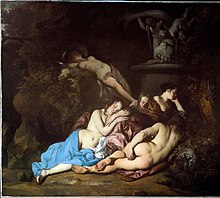
Legacy

In his lifetime, Lely was known as a skillful connoisseur of art. His collection of Old Masters, including Veronese, Titian, Claude Lorrain and Rubens, and a fabulous collection of drawings, was broken up and sold after his death, raising the immense sum of £26,000. Some items in it which had been acquired by Lely from the Commonwealth dispersal of Charles I's art collections, such as the Lely Venus, were re-acquired by the Royal Collection.
He was replaced as court portraitist jointly by John Riley and Sir Godfrey Kneller, also a German-born Dutchman, whose style drew from Lely's but reflected later Continental trends.
A horse was also named after him, finishing fourth in the 1996 Grand National.
Style
Lely was first and foremost a portraitist. He painted both men and women, but with a greater inclination towards the latter, whose cleavage was often accentuated, sometimes to the point of having one breast fully exposed (such as in Margaret Hughes's earlier portrait, seen below).
The loss in 1929 of a "family portrait by Sir Peter Lely" was reported in the fire at Pit House, Farley Heath, Albury.
Gallery
- Peter Lely's works
-
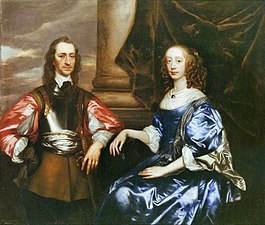 Earl and Countess of Oxford
Earl and Countess of Oxford
-
 Sir Robert Worsley, 3rd Baronet
Sir Robert Worsley, 3rd Baronet
-
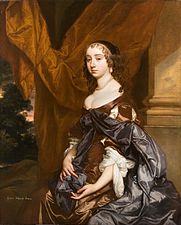 Lady Mary Fane by Sir Peter Lely
Lady Mary Fane by Sir Peter Lely
-
 Queen Mary II
Queen Mary II
-
 Portrait of a man, thought to be George Booth, Lord Delamere, 1660
Portrait of a man, thought to be George Booth, Lord Delamere, 1660
-
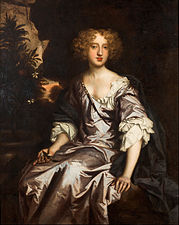 Portrait of Lady Elizabeth Strickland, née Pile
Portrait of Lady Elizabeth Strickland, née Pile
-
 Catherine of Braganza, Queen of England 1665
Catherine of Braganza, Queen of England 1665
-
 Portrait of a Lady with a Blue Drape, circa 1660
Portrait of a Lady with a Blue Drape, circa 1660
-
 Abraham Cowley, c. 1665–66
Abraham Cowley, c. 1665–66
-
 Two ladies from the Lake family, 1650.
Two ladies from the Lake family, 1650.
-
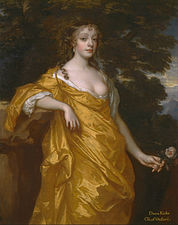 Diana Kirke, later Countess of Oxford, 1665
Diana Kirke, later Countess of Oxford, 1665
-
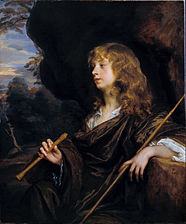 A Boy as a Shepherd
A Boy as a Shepherd
-
 Charles II of England, c. 1675
Charles II of England, c. 1675
-
 Jane Howard, Duchess of Norfolk
Jane Howard, Duchess of Norfolk
-
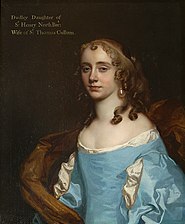 Dudley, Daughter of Sr. Henry North, Bart., Wife of Sir Thomas Cullum
Dudley, Daughter of Sr. Henry North, Bart., Wife of Sir Thomas Cullum
-
 Sir Thomas Fanshawe of Jenkins and his wife Margaret
Sir Thomas Fanshawe of Jenkins and his wife Margaret
-
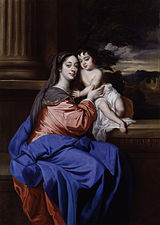 Madonna and Child by Sir Peter Lely
Madonna and Child by Sir Peter Lely
-
 Sir William Ashburnham
Sir William Ashburnham
-
 Lady Frances Savile, Later Lady Brudenell
Lady Frances Savile, Later Lady Brudenell
-
 Portrait of Margaret Hughes c. 1670.
Portrait of Margaret Hughes c. 1670.
-
 Portrait of Charlotte Lee, Countess of Lichfield 1674
Portrait of Charlotte Lee, Countess of Lichfield 1674
-
 Sir John Holland, 1st Baronet
Sir John Holland, 1st Baronet
-
 Sir Thomas Lee, 1st Baronet
Sir Thomas Lee, 1st Baronet
Citations
- Asquith, Richard (1 December 2024). "A Bluesky thread about incorrect dating of Lely's death". Bluesky. Retrieved 1 December 2024.
- "Artist Info". nga.gov. Retrieved 7 January 2023.
- ^ "Sir Peter Lely, Dutch Painter". Encyclopædia Britannica. Retrieved 21 December 2018.
- Ellis Waterhouse, Painting in Britain, 1530–1790, 1953, Penguin Books (now Yale History of Art series)
- Britannica 2018. Dethloff 2009
- Sainty, J.C.; Bucholz, R.O. (1997). Officials of the Royal Household, 1660–1837: Department of the Lord Chamberlain and associated offices. Office-holders in modern Britain. University of London, Institute of Historical Research. p. 51. ISBN 978-1-871348-40-8. Retrieved 1 May 2019.
In 1660 Lely was appointed 'Limner and Picture Drawer', being succeeded in 1681 by Riley as 'Painter and Picture Drawer'.
- Hamilton, Adrian (16 April 2012). "Carry on, your majesty: Charles II and his court ladies". The Independent. Archived from the original on 18 June 2022. Retrieved 25 April 2019.
- Art History News, quoting his Evening Standard review of the 2012 Lely exhibition, "Small but perfectly formed"
- Cust 1893, p. 21.
- "Pit House" (PDF). Albury History Society – buildings – Pit House. Albury History Society. Retrieved 13 June 2022.
General references
- Cust, Lionel Henry (1893). "Lely, Peter" . In Lee, Sidney (ed.). Dictionary of National Biography. Vol. 33. London: Smith, Elder & Co. pp. 19–21.
- Dethloff, Diana (21 May 2009). "Lely, Sir Peter (1618–1680)". Oxford Dictionary of National Biography (online ed.). Oxford University Press. doi:10.1093/ref:odnb/16419. (Subscription or UK public library membership required.)
- "Sir Peter Lely". Britannica.com. 11 September 2018.
- Millar, Oliver (2002) . "Lely, Sir Peter". Grove Dictionary of Art. Vol. 19. London. pp. 119–125.
{{cite encyclopedia}}: CS1 maint: location missing publisher (link) The entry includes a bibliography. - Millar, Oliver (1978). Sir Peter Lely 1618–80. London: National Portrait Gallery.
- Rossetti, William Michael (1911). "Lely, Sir Peter" . Encyclopædia Britannica. Vol. 16 (11th ed.). p. 408.
- Waterhouse, Ellis (1978). Painting in Britain 1530 to 1790 (Fourth ed.). New York: Viking Penguin.
- Whinney, Margaret; Millar, Oliver (1957). English Art 1625–1714. Oxford: Clarendon Press.
External links
- The Oliver Millar Archive; research papers of Oliver Millar, British art historian and a leading authority on Peter Lely
- 612 artworks by or after Peter Lely at the Art UK site
- Self-portrait from the National Portrait Gallery
- Biography from the J. Paul Getty Museum
- Biography from the National Maritime Museum, Greenwich
- Biography from the Web Gallery of Art
- Sir Peter Lely at the WikiGallery.org
- History collection from Frits Lugt's Les marques de collections de dessins & d'estampes
- Nympths by a Fountain from the Dulwich Picture Gallery
- An engraving by Henry Thomas Ryall of
 Edward, First Earl of Sandwich. for Fisher's Drawing Room Scrap Book, 1837 with a poetical illustration by Letitia Elizabeth Landon that relates to the 4th Earl.
Edward, First Earl of Sandwich. for Fisher's Drawing Room Scrap Book, 1837 with a poetical illustration by Letitia Elizabeth Landon that relates to the 4th Earl.
| Court offices | ||
|---|---|---|
| Preceded byAnthony van Dyck | Principal Painter in Ordinary to the King 1661–1680 |
Succeeded byGodfrey Kneller |
- 1618 births
- 1680 deaths
- People from Soest, Germany
- 17th-century English painters
- English male painters
- Knights Bachelor
- British Baroque painters
- Principal Painters in Ordinary
- Dutch Golden Age painters
- Dutch male painters
- Painters from Haarlem
- German emigrants to the Dutch Republic
- Dutch emigrants to England
- Naturalised citizens of the United Kingdom
- People of the Second Anglo-Dutch War